 |
Magazine Fort
Dublin, Ireland
|
|
 |
Constructed: 1735
Used by: Great Britain, Ireland
Conflict in which it participated:
The Troubles
|
Now's here's a proof of Irish sense
Here Irish wit is seen
When nothing's left that's worth defence,
We build a Magazine.
-Jonathan Swift, re: Magazine Fort, c. 1737
Dublin was settled around 841AD by Vikings. Were Vikings the first people to call Dublin home? Of course not, Vikings wouldn't have even bothered with the place had there not been someone there from whom to violently take it. Some sort of Christian settlement was probably there before the Vikings showed up.
|
 |
|
|
The name Dublin comes from two old Irish words: Dubh, which means dark or black; and lind, meaning pool. This is thought to refer to a dark tidal pool that existed where the Poddle River meets the Liffey River in the heart of modern Dublin. The Vikings controlled the region until the Norman Invasion of Ireland in the late 12th century, after which England's King Henry II (1133-1189) declared himself to be Lord of Ireland. Henry's successor, King John (1166-1216), ordered that a fortification be built in Dublin starting in 1204: The result was Dublin Castle, which remains today as an important government complex. The Record Tower, built around 1230, is the only remnant of this original castle that still stands aboveground. The Knights Hospitallers, a Catholic military order with a long history of fortification, star-shaped and otherwise (see Fort Saint Elmo at Valetta, Malta), were granted a large tract of land at Dublin in the 12th century by Hugh Tyrrel (d.1199). Tyrrel was the first Baron of Castleknock, and had played enough of a role in the Norman Invasion that he now had so much land, he could hand large swaths of it out to such organizations as the Knights Hospitallers. |
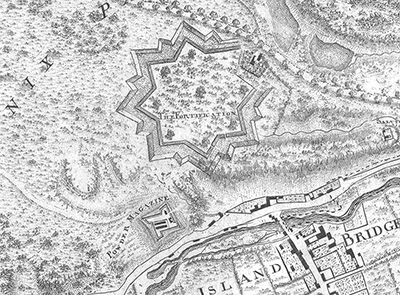 A section of a map of Dublin dated 1757, which shows Magazine Fort's relationship to a nearby earthwork starfort, which was creatively named, "The Fortification." A section of a map of Dublin dated 1757, which shows Magazine Fort's relationship to a nearby earthwork starfort, which was creatively named, "The Fortification." |
 |
Those Hospitallers lost their Irish lands thanks to the Dissolution of the Monasteries, which occurred betwixt 1536 and 1541. This was one of the results of King Henry VIII (1491-1547)'s dogged determination that a woman to whom he was married would produce for him a male heir. That an insufficiency of such heirs were produced by any of Henry's six wives was of course their fault, as it was inconceivable that the Royal Tallywhacker could shoot blanks.
When Pope Paul III (1468-1549) refused to grant an annulment of Henry's first marriage, Henry broke all of England away from the Catholic church, embracing instead the Anglican Church, under which Henry could marry as many unfortunate women as he wished. |
|
(Henry did ultimately manage to bully his third wife, Jane Seymour (1508-1537), into producing for him a man-child: Edward VI (1537-1553) became king-child at the age of nine upon his father's death in 1547, but wife #3 died in childbirth.)
Whatever, the land that had formerly belonged to the Knights Hospitallers in Dublin had by the mid-17th century become a Royal Hunting Park, teeming with delicious deer and pheasant. A wall was built around this property to help prevent poaching, and Phoenix Park was born.
In 1710, Thomas Burgh (1670-1730), the Lieutenant of Ordnance for Ireland, began work on a large earthwork starfort in Phoenix Park. Though this starfort was never completed (note the unfinished wall at the fort's northeastern extent in the picture above), it was determined by Lionel Sackville (1688-1765), then the Lord Lieutenant of Ireland, that a separate powder store was needed to supply the larger fortification.
|
Which means we're finally talking about Magazine Fort! Phoenix Lodge, the house from whence Phoenix Park took its name, had been built on St. Thomas' Hill in 1611...and was unceremoniously razed so that Magazine Fort could be built on the same spot. The reason for Thomas Swift's ditty with which this page began, in which Mr. Swift makes fun of the starfort of our current interest, was that Dublin was relatively impoverished at that time: What is there to defend in such a situation, he wonders? Hush up, Jonathan, we're getting a starfort out of this weird situation.
|
 |
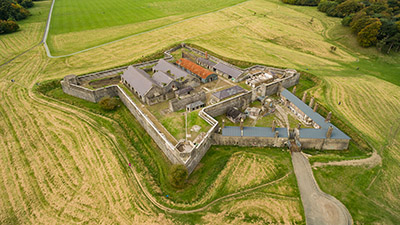 Holy cannolis. Magazine Fort may be in the process of rotting away from neglect, but it's certainly still lovely from this angle! Holy cannolis. Magazine Fort may be in the process of rotting away from neglect, but it's certainly still lovely from this angle! |
|
British engineer John Corneille designed Magazine Fort, which was surrounded by a dry moat, and whose walls were five feet thick. A fort's powder magazine is always an interesting structure, but seldom does that magazine take the shape of an entire starfort! Magazine Fort was designed to be exactly what its name describes: A self-contained, defensible store for powder and shot.
|
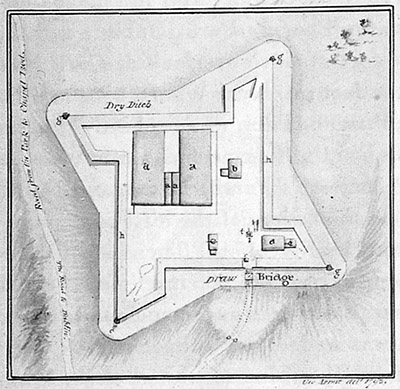 A 1793 plan of Magazine Fort, from the National Library of Ireland. Click on it, it's bigger. A 1793 plan of Magazine Fort, from the National Library of Ireland. Click on it, it's bigger. |
 |
The 1793 plan to the left shows that a howitzer was kept trained on the main gate from inside, ready for the wicked Irish (or equally wicked French) to attempt to come a-stormin' in. Several barrel-vaulted magazine chambers are contained within the fort. These were served by overhead cranes and gantries, for hefting powder kegs about.
The triangle of barracks we see on Magazine Fort's south side were added in 1801. The Fortification, the earthen starfort which Magazine Fort was built to support, was demolished in the 1830's. Perhaps Jonathan Swift was onto something after all.
Once the Fortification was dismantled, Magazine Fort became Great Britain's stronghold in Dublin, second in importance only to Dublin Castle. By 1890, Magazine Fort had ten 12-pounder guns mounted within for its defense, and then concrete machine gun pillboxes were added atop the fort's bastions at the start of the 20th century. |
|
A pillbox on a starfort is a somewhat unusual occurrence, though understandable in this situation. How better to mow down the army of Irish Republicans who were sure to eventually advance upon Magazine Fort?
|
By the time of the Easter Rising of 1916, in which Irish Republicans rose up to declare an end to British rule of Ireland, Magazine Fort was chock full of British arms and ammunition. In one of the first acts of this rebellion, a small team of rebels overwhelmed the unprepared guards at Magazine Fort around midday on Easter Monday: So much for those pillboxes!
The rebels' plan was to cart off guns and ammunition, then blow up the fort as a signal that the uprising had begun. They may or may not have made it out with some weapons, but the fort remained blessedly un-blowed-up: Charges were set and fuses lit, but those fuses failed somewhere along the line.
|
 |
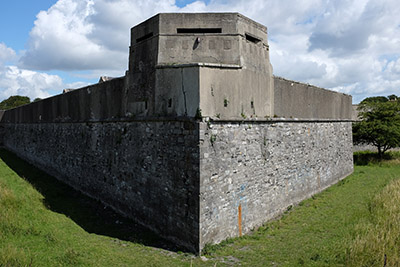 What a starfort bastion might have looked like if it had been built during the First World War. A machine gun pillbox serves as the 20th-century version of the guerite! What a starfort bastion might have looked like if it had been built during the First World War. A machine gun pillbox serves as the 20th-century version of the guerite! |
|
The Easter Rising was unsuccessful, but not the end of Ireland's quest for independence. Showing an Irish penchant for doing violent things on major religious holidays, the Christmas Raid of 1939 brought the Irish Republican Army to Magazine Fort. By 1939 Magazine Fort was Ireland's largest arms cache, and was under the control of the Irish Army. The Irish Republican Army, however, felt as though all of Ireland's army-ing should be left to them, thank you kindly, and thus overpowered the relatively small number of troops on duty at the fort at about 8:30pm on December 23, 1939. It might be noted that, for all of Magazine Fort's impressive pointy bastions and pillboxes, it has repeatedly proven to be incapable of defending itself from small groups of people holding pistols. Although I wouldn't blame the fort itself for that.
|
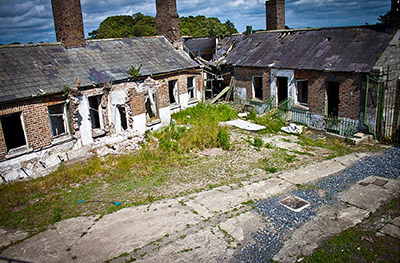 The current state of Magazine Fort's interior buildings. Shameful. The current state of Magazine Fort's interior buildings. Shameful. |
 |
A reported "1,084,000" rounds of ammunition were trucked off into the night, the vast majority of which was recovered within a week. The Irish government's reaction was swift and stern, resulting in a net loss for the IRA.
The Irish Army maintained Magazine Fort as an ammunition store until 1988, at which time 'twas was handed over to the Office of Public Works, an organization dedicated to the upkeep of Ireland's historic structures. While the OPW has done some work stabilizing some of the fort, it exists today in a rather shoddy state, undeveloped for visitors, and not open to the public. |
|
For anyone interested in seeing more of Magazine Fort, might I suggest Abandoned Ireland's Magazine Fort photo gallery. These folks recently visited the dilapidated fort, and offer several impressive "virtual reality" pages, at which one can view beautiful 360° interior views of the fort, in all its present ramshackle majesty. |
|
|
|
|
|
 |




